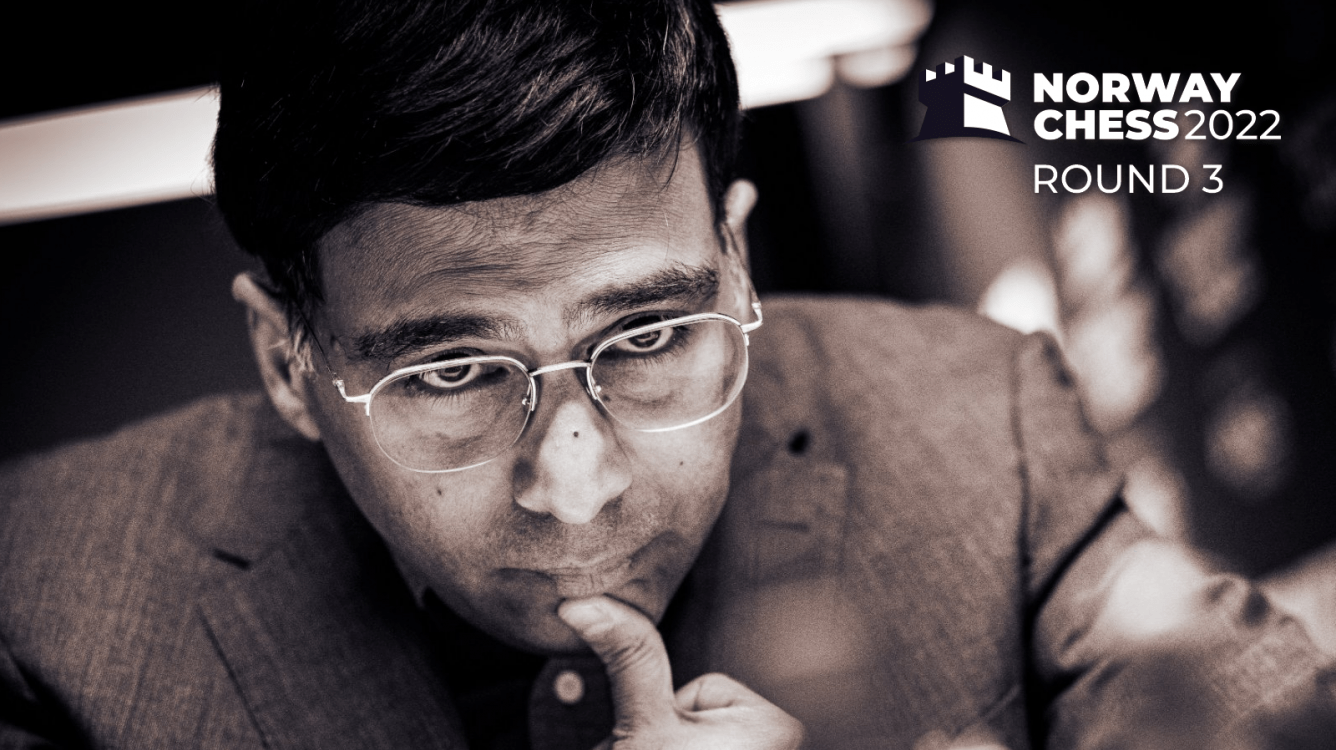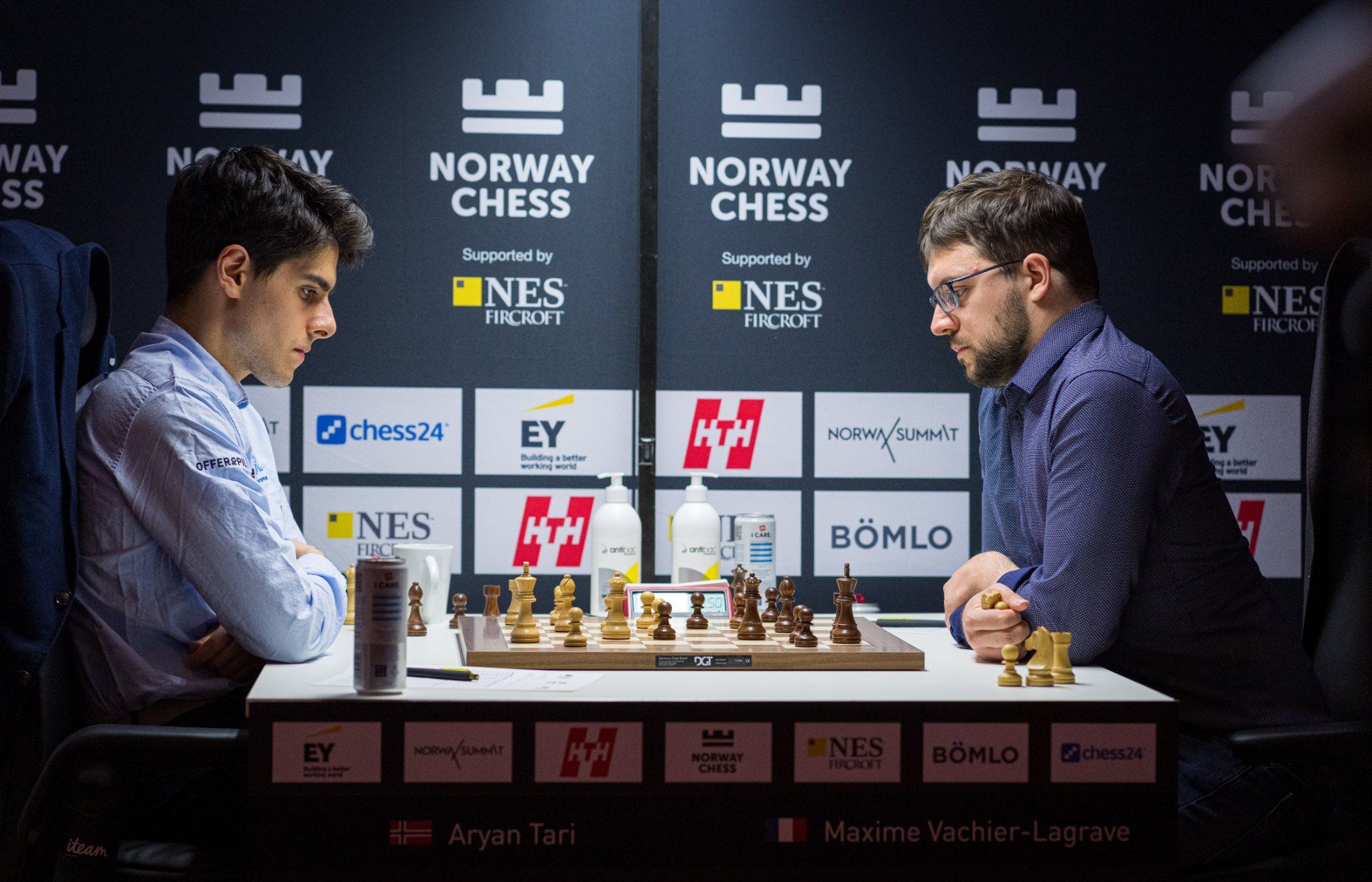
Tiger Of Madras Returns - Vintage Anand Leads
Has GM Viswanathan Anand been retigered? As the events unfold this week at 2022 Norway Chess in Stavanger, the 52-year-old is certainly beginning to make it look like it.
The former world champion continued to demonstrate that he is still very much a force to be reckoned with as he took down GM Wang Hao in the armageddon game to hang on to his commanding lead of the tournament. Meanwhile, World Champion Magnus Carlsen won his first classical game of the event.
This leaves Anand in first place with 7.5 points, ahead of GM Wesley So with 6.0, and Carlsen on 5.5.
How to watch?
You can follow the 2022 Norway Chess with expert commentary on Chess.com/TV or on our Twitch channel. You can also catch all our live broadcasts on YouTube.com/ChesscomLive.
Follow the 2022 Norway Chess games live on our dedicated page on Chess.com/events.
"Vishy retigered" was a Tweet by GM Anish Giri back during the Superbet Rapid & Blitz even in Warsaw, a little more than a week ago, when Anand led to nearly everyone's surprise, most of the way. It certainly seems like it was the perfect warmup for this event because his thirst for blood is back and his fangs are sharp enough to take advantage of the opportunities that have arisen along the way.
Anand-Wang Hao
With wins in the first two games, the Indian veteran had come off to the perfect start, and as White in the third game, it was natural to hope for even more, particularly considering that Wang Hao had officially retired at the end of the Candidates tournament last year. Of course, the Chinese grandmaster would not accept an invitation to an event such as Norway Chess and then show up unprepared. But you are allowed to hope for more wins for Anand.
Wang Hao by contrast had struggled a bit, having lost both of his armageddon games and showing a bit of luck against Carlsen to even make it out alive of the classical game.
In a Sveshnikov Sicilian, Anand opted for the relatively rare 13.a3, but despite this choice, the players still followed prior praxis until move 20. While it did seem that White had some pressure, Black never seemed to be far away from equality. When the players entered a rook ending with an extra pawn for Anand, they shortly after agreed to share the point, well aware that established endgame theory had established the particular endgame as a straightforward draw.
In the armageddon game, Anand decided to avoid a repetition of the Sveshnikov and instead played the Rossolimo Variation, 3.Bb5. Wang Hao decided to go for the sharp and somewhat risky 5...e5 that requires White to sacrifice a pawn if he wants to achieve anything in the opening.
Anand did sacrifice a pawn and could actually have decided the game in the opening after a massive blunder by Black on move 10. Anand missed it but kept the initiative. Black had several chances to equalize, indeed even a draw on move 29, but did not find any of them and despite several mistakes from both players, Anand found a way to win the game.
Carlsen-Radjabov
Part of the background story for this game is that Carlsen had been a little critical of GM Teimour Radjabov's decision not to play in the previous Candidates Tournament, which awarded him a spot in this year's Candidates (starting shortly after the conclusion of this event).
Another part is that Carlsen's challenger in last year's world championship match, GM Ian Nepomniachtchi, played a particular line against Carlsen's Catalan and got a good game, and it was this particular line that Radjabov now played against Carlsen.
The critical line, which was tested in both So-Nepomniachtchi in Bucharest a couple of weeks ago, involves a pawn sacrifice by Black. In return for the sacrificed pawn, Black gets active piece play, whereas White has to release himself from Black's pressure quite gradually, and that is easier said than done.
Carlsen launched a novelty on move 13, which had definitely not been part of Radjabov's pregame preparation because he immediately went in the tank and spent more than 30 minutes on the next couple of moves. He then shortly after played the inaccurate 15...Nec5 which made Carlsen quite happy.
However, being happy is rarely sufficient to win a game; for that purpose, you need good moves, and Carlsen consistently found those, including some really ugly ones, such as 19.Qb1 and 22.Kf1, which helped White ease the pressure from Black's positional compensation.
As he got his pieces into play, and Black got shorter on time, White's advantage steadily grew, and shortly before the time control, Radjabov threw the towel in the ring.
In the post-game interview, a relieved Carlsen said, "I'm very, very happy. It's very rare that you follow a plan from move one and it works perfectly. I took a pawn and defended it in a very ugly way and that passed pawn won me the game, so I'm very happy with that!"
... It's very rare that you follow a plan from move 1 and it works perfectly.
-World Champion Magnus Carlsen

By contrast, Radjabov cannot be particularly happy with his play. He finished in a shared last place in the blitz event, and after three rounds in the classical event, he is in sole possession of last place. Hardly what you would call ideal preparation for the Candidates Tournament.
Giri-So
If there was ever a game I felt more confident would end in a draw it was this one between Giri and So. Both players are solid, extremely well-prepared, and very difficult to beat. The classical game saw Black play a Nimzo-Indian. The players hammered out a bunch of moves and soon went fast toward the inevitable draw after following previous games until Black's 19th move. Then the players went for a sequence that exchanged nearly all the remaining pieces. Once the players passed move 30, they agreed on a draw.
For the armageddon game, Giri decided to switch to 1.e4, to which So replied 1...e5 and went for a Berlin Defense against Giri's Ruy Lopez.
Unlike the classical game, the players soon departed from established theory. and So chose an approach that first equalized and then allowed him to put White under some pressure. After a blunder by White on move 27, Black gained a decisive advantage that would have won him the game had he not settled for a draw. Giri had no choice but to accept.
Mamedyarov-Topalov
A few weeks ago in Bucharest, simply nothing was working out for GM Shakhriyar Mamedyarov and he finished dead last. Here, on the other hand, he is off to a solid start. GM Veselin Topalov has played well but is still a bit rusty, something that mostly manifests itself in taking too long to make the moves, causing time trouble. When playing in an event such as this, time trouble never ends, because when you hit move 40, you only receive increments, not bonus time, so you will never actually leave the time trouble stage. Against Anand in round two, it cost Topalov the game when he lost on time.
In the classical game, the player debated in a topical line of the Slav Defense. Black equalized and soon got a comfortable game where White's bishops never gained the power White had hoped for. But despite achieving his objective, Black never really had any kind of meaningful advantage either. The evaluation always seemed to be marginally better for White or Black. Prior to the time control, it was only on move 34 that White had a chance for a clear advantage with proper winning chances. That, however, was missed.
After the time control, the players played something that was incredibly complicated and almost impossible to get a solid grasp on, even the engines disagreeing with themselves regarding the evaluation of the moves. The fact the game ended in a draw is a bit of a miracle considering the pawn and piece distribution with pawn races on opposite wings, but it is also a testament to the resourcefulness of the two players.
Rather than trying to make sense of it here, I will recommend you take a look at the game for yourself.
In the armageddon game, the players instead tested each other in a Catalan Opening where White gained the bishop pair and a small but clear advantage out of the opening. White's best chance was missed after Black played the weakening 26...f6? where Mamedyarov could have played 27.Bg4!.
After that, Black was fine, and when Mamedyarov blundered on move 33, Black got an almost winning endgame, but already in serious time trouble, Topalov counter-blundered shortly thereafter, leaving the chances about even. Black's main problem, however, was that he was down to less than 20 seconds on the clock and Mamedyarov did his best to make Topalov's life miserable. In particular, White's 51.g4! was a strike of time-trouble gold. It did not win outright, but it was impossible for Black to defend accurately when the position on the board is secondary to that on the clock.
In the end, White got a winning position on the board and that was when Topalov's clock gave out as well.
Tari-Vachier-Lagrave
During the second round, we heard about Vachier-Lagrave's wishes about playing a Najdorf Sicilian. In the game in round three, he had the Black pieces in a Sicilian, but like against Anand, he had to deal with yet another 3.Bb5+, the so-called Moscow Attack. GM Aryan Tari chose the somewhat unusual 4.c4, a move he has tried on several previous occasions.

Black, nevertheless managed to equalize, and after some mistakes by Tari, the white position started collapsing, allowing Black to win in style.
In the confessional booth during the game, Vachier-Lagrave expressed that this would hopefully stop players from playing anymore 3.Bb5+s against him. I suspect that this is a rather optimistic hope.
Round 3 Standings

All Games Round 3
The 2022 Norway Chess runs May 31-June 10, 2022. The event consists of a 10-player single round-robin in a classical time control of 120 minutes for the game with a 10-second increment after move 40. The scoring system is three points for a win instead of the usual one. If the game is drawn, competitors play an armageddon game with the winner scoring 1.5 points and the loser 1 point. The prize fund is 2.5 million Norwegian kroner (NOK).
Previous coverage:


